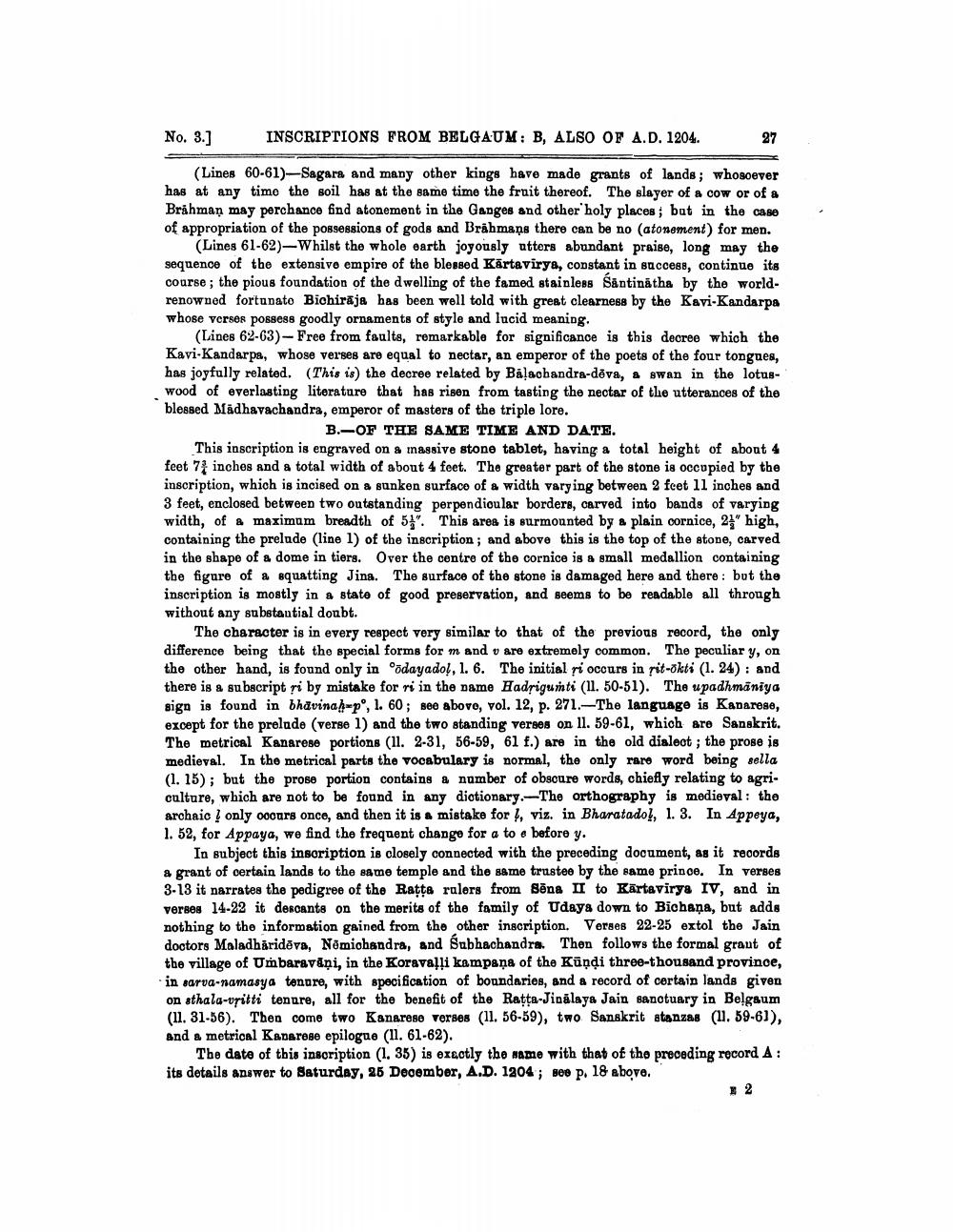________________
No. 3.]
INSCRIPTIONS FROM BELGAUM: B, ALSO OF A.D. 1204.
27
(Lines 60-611-Sagara and many other kings have made grants of lands; whosoever has at any time the soil has at the same time the fruit thereof. The slayer of a cow or of a Brahman may perchance find atonement in the Ganges and other holy places; but in the case of appropriation of the possessions of gods and Brāhmaṇs there can be no (atonement) for men.
(Lines 61-62)-Whilst the whole earth joyously utters abundant praise, long may the sequence of the extensivo empire of the blessed Kārtavirya, constant in success, continue its course; the pious foundation of the dwelling of the famed stainless Säntinātha by the worldrenowned fortunato Bichirāja has been well told with great clearness by the Kavi-Kandarpa whose verses possess goodly ornaments of style and lucid meaning,
(Lines 62-63)- Free from faults, remarkable for significance is this decree which the Kavi-Kandarpa, whose verses are equal to nectar, an emperor of the poets of the four tongues, has joyfully related. This is the decree related by Balachandra-dova, a swan in the lotuswood of everlasting literature that has risen from tasting the nectar of the utterances of the blessed Mädhavachandra, emperor of masters of the triple lore.
B.-OF THE SAME TIME AND DATE. This inscription is engraved on a massive stone tablet, having a total height of about 4 feet 7 inches and a total width of about 4 feet. The greater part of the stone is occupied by the inscription, which is incised on a sunken surface of a width varying between 2 fcet 11 inches and 3 feet, enclosed between two outstanding perpendicular borders, carved into bands of varying width, of a maximum breadth of 5". This area is surmounted by a plain cornice, 21 high, containing the prelude (line 1) of the inscription; and above this is the top of the stone, carved in the shape of a dome in tiers. Over the centre of the cornice is a small medallion containing the figure of a squatting Jina. The surface of the stone is damaged here and there : but the inscription is mostly in a state of good preservation, and seems to be readable all through without any substantial doubt.
The character is in every respect very similar to that of the previous record, the only difference being that the special forms for m and v are extremely common. The peculiar y, on the other hand, is found only in Põdayadol, 1. 6. The initial ri occurs in rit-okti (1. 24): and there is a subscript ri by mistake for ri in the Dame Hadrigunti (11. 50-51). The upadhmaniya siga is found in bhavinah-p, 1. 60; see above, vol. 12, p. 271.-The language is Kadarese, except for the prelude (verse 1) and the two standing verses on 11. 59-61, which are Sanskrit. The metrical Kanarese portions (11. 2-31, 56-59, 61 f.) are in the old dialect; the prose is medieval. In the metrical parts the vocabulary is normal, the only rare word being sella (1. 15); but the prose portion contains a number of obscure words, chiefly relating to agriculture, which are not to be found in any dictionary.--The orthography is medieval: the archaic I only oocars once, and then it is a mistake for ļ, viz. in Bharatado!, 1. 3. In Appeya, 1. 52, for Appaya, we find the frequent change for a to o before y.
In subject this inscription is closely connected with the preceding document, as it records a grant of certain lands to the same temple and the same trustee by the same prince. In verses 3-13 it narrates the pedigree of the Ratta ralers from Sēna II to Kärtavirya IV, and in verses 14-22 it descants on the merits of the family of Udaya down to Bichana, but adds nothing to the information gained from the other inscription. Verdes 22-25 extol the Jain doctors Maladharidova, Nomichandra, and Subhachandra. Then follows the formal grant of the village of Umbaravāni, in the Koravaļļi kampaņa of the Kūņdi three-thousand province, in sarva-namasya tenore, with specification of boundaries, and a record of certain lands given on sthala-vpitti tenure, all for the benefit of the Ratta-Jinālaya Jain sanotuary in Belgaum (11. 31-56). Then como two Kanarese verses (11. 56-59), two Sanskrit stanzas (11. 59-61), and a metrical Kadarese epilogue (11. 61-62).
The date of this insoription (1. 35) is exactly the same with that of the preceding record A : its details answer to Saturday, 25 December, A.D. 1204 ; see p. 18 above,




